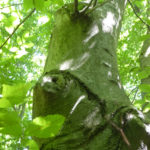 We just returned home from our Arizona visit and are happy to be back at Shaman’s Grove. It’s nice to go away, but GREAT to get home. It makes us really appreciate the peace and gentle energy of our forest home.
We just returned home from our Arizona visit and are happy to be back at Shaman’s Grove. It’s nice to go away, but GREAT to get home. It makes us really appreciate the peace and gentle energy of our forest home.
About a month ago, I ran across this blog from The Druid’s Garden. I was waiting for permission to re-post this for you as it’s a great post. The permission arrived today and just in time for a weekly posting (we were both out of town). I will re-post more of Dana’s blogs later – her tree series is wonderful!
So, I hope you enjoy this and can go play in the trees this weekend.
Until next time –
Pleasant Journeys,
Debbie
Druid Tree Workings: Finding The Face Of The Tree
Sometimes the trees themselves share lessons
with us about how to work with them, to talk with them, heal with them. These are often presented to me as mystery teachings from the trees themselves–and I’ll be sharing some of these teachings with you. The first of these is finding the face of the tree.
I have found that each tree has at least one face and finding it can teach you a lot about that particular tree’s personality and energy. Finding the face of the trees will show you their individuality and unique personality–and yes, individual trees do have uniqueness of their own, both inside and out. This is similar to humans—all humans are humans, but we come from different ethnicities and different regions and those create variation. In the same way, all oak trees have a strengthening quality to them because of their nature: how they grow, their extensive root systems, their tannins, etc. But like people, each oak has his or her own personality and quirks. Finding the face of the tree gives one insight into those personalities and quirks that a tree possesses and gives mean for communication.
What do I mean by the face of the tree? Usually, somewhere on the bark, there is a face or a part of a face–some variation of the bark that allows you to see a message. You may see an eye or some other feature that shows you the tree’s nature (one of the images below has a heart in the bark…you get it). The face of a tree is almost always found in its bark—look at the irregularities in the bark, the knotholes, bumps, or other features and you will find the face of the tree. Some trees may have many faces (like beech trees, which I’m using in this post) or smaller face that combine into a large face. If you directly address the tree at its face, you will more likely get a response. How high up the face may be gives you a sense of the tree’s accessibility and friendliness. Faces that are well off of the ground may indicate that the tree does not wish to be approached; faces that are near the ground and clearly accessible may indicate the opposite. Some tree species, like maple or beech, have many many faces present on their smooth bark. Other tree species, like some conifers, require a bit more studying to see the face.
Let’s look at a few examples: (read the full blog with pictures here)
